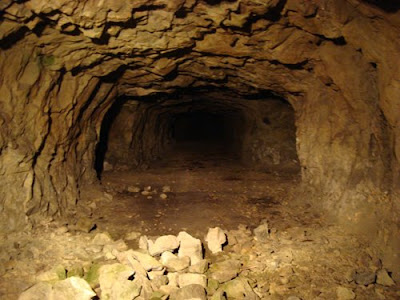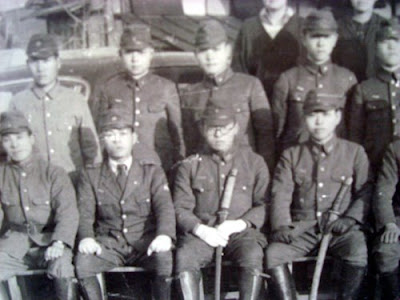松代大本営
As Japan faced certain defeat in World War II, special plans were put in place to move the Emperor and the main organs of the Japanese state, including the ministries and NHK, to underground bunkers in the mountains of Nagano Prefecture.

The thinking was to prepare for a final battle to inflict such damage on the Allies as they would accept the continuation of the Imperial system. A special chamber was constructed to house the Emperor and his family underneath the hard rock.

Construction of the 6km-long underground tunnels and shelters began in late 1944, when around 7,000 Korean forced laborers were moved into hastily-built camps at the site at Mount Zozan and local residents were evicted.

Construction work continued around the clock in terrible conditions. Workers were fed a meager diet and it is estimated that around 1,000 people died from malnutrition, execution and accidents as the rock was dynamited and carried out by hand on wooden trolleys and in rope nets.
All records of the operation were destroyed at the end of the war and only the names of 3 Koreans workers and a Japanese who died at the site are now known: Tosan Paku, Kisuru Kim, Tokusu Chou and Jiro Nakano.
Also at Mount Zozan an ianjo or "comfort women station" was established when four young Korean women were brought to Matsushiro on the promise of work as "special nurses" to serve the Japanese guards and high-ranking Koreans.

The women disappeared at the end of the war and their fates remain unknown. The building where the comfort women were kept was dismantled in 1991. The Organization for the Memorial Center of Another History in Matsushiro has preserved the remains of the structure and has plans to re-erect the building as a war memorial. So far, these plans are on hold due to lack of financing (30m yen is the projected budget) and some opposition amongst the local people.
A school project in 1985 brought to light the tragic history of the tunnels and the Nagano city government secured and opened 500m of the shelter complex to the public after pressure from the local community. The tunnels are administered by the sightseeing section of Nagano city and there is local concern that not enough emphasis is placed on the historical and educational aspects of the site.

At the site is a memorial stone in Japanese and Korean.
Entrance to the tunnels is free.
Hours are 9am-4pm.
Tel: 026 224 8316
Matsushiro city page on Daihonei
The small historical museum mouitotsunorekishikan (もういとつの歴史館; "Another History Museum") to the right before the main entrance to the tunnel, exhibits tools and photographs reconstructing the harsh existence of the workers with a stirring introduction in Japanese by the museum's guide (admission 200 yen).

To reach the tunnels take a Nagano Dentetsu Yashiro Line train to Matsushiro Station from Nagano and then walk south about 20 mins. Alternatively, take the more frequent bus from Nagano Station to Matsushiro from bus platform #3 outside the station.
Yahoo Japan Auction Service
Book a hotel in Japan with Bookings
Tokyo Serviced Apartments
Japan Friends
Happi Coats
Japanese For Busy People
Tags
Nagano Matsushiro WWII
As Japan faced certain defeat in World War II, special plans were put in place to move the Emperor and the main organs of the Japanese state, including the ministries and NHK, to underground bunkers in the mountains of Nagano Prefecture.

The thinking was to prepare for a final battle to inflict such damage on the Allies as they would accept the continuation of the Imperial system. A special chamber was constructed to house the Emperor and his family underneath the hard rock.

Construction of the 6km-long underground tunnels and shelters began in late 1944, when around 7,000 Korean forced laborers were moved into hastily-built camps at the site at Mount Zozan and local residents were evicted.

Construction work continued around the clock in terrible conditions. Workers were fed a meager diet and it is estimated that around 1,000 people died from malnutrition, execution and accidents as the rock was dynamited and carried out by hand on wooden trolleys and in rope nets.
All records of the operation were destroyed at the end of the war and only the names of 3 Koreans workers and a Japanese who died at the site are now known: Tosan Paku, Kisuru Kim, Tokusu Chou and Jiro Nakano.
Also at Mount Zozan an ianjo or "comfort women station" was established when four young Korean women were brought to Matsushiro on the promise of work as "special nurses" to serve the Japanese guards and high-ranking Koreans.

The women disappeared at the end of the war and their fates remain unknown. The building where the comfort women were kept was dismantled in 1991. The Organization for the Memorial Center of Another History in Matsushiro has preserved the remains of the structure and has plans to re-erect the building as a war memorial. So far, these plans are on hold due to lack of financing (30m yen is the projected budget) and some opposition amongst the local people.
A school project in 1985 brought to light the tragic history of the tunnels and the Nagano city government secured and opened 500m of the shelter complex to the public after pressure from the local community. The tunnels are administered by the sightseeing section of Nagano city and there is local concern that not enough emphasis is placed on the historical and educational aspects of the site.

At the site is a memorial stone in Japanese and Korean.
Entrance to the tunnels is free.
Hours are 9am-4pm.
Tel: 026 224 8316
Matsushiro city page on Daihonei
The small historical museum mouitotsunorekishikan (もういとつの歴史館; "Another History Museum") to the right before the main entrance to the tunnel, exhibits tools and photographs reconstructing the harsh existence of the workers with a stirring introduction in Japanese by the museum's guide (admission 200 yen).

To reach the tunnels take a Nagano Dentetsu Yashiro Line train to Matsushiro Station from Nagano and then walk south about 20 mins. Alternatively, take the more frequent bus from Nagano Station to Matsushiro from bus platform #3 outside the station.
Yahoo Japan Auction Service
Book a hotel in Japan with Bookings
Tokyo Serviced Apartments
Japan Friends
Happi Coats
Japanese For Busy People
Tags
Nagano Matsushiro WWII
コメントを投稿